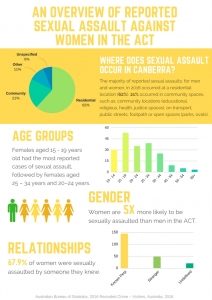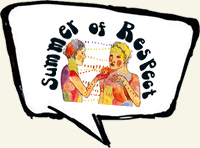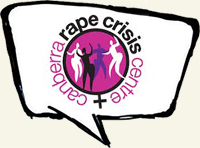Before you read on it’s important to make sure you understand and get the right information.
What is Sexual Violence?
It is important to know what sexual violence is so that it is able to be recognized and called out.
1 in 5 women and 1 in 20 men have experienced sexual violence since the age of 15 (ABS, Personal Safety Survey, 2006). This could mean that around 35, 440 women and 8,750 men in the ACT have experienced sexual violence since the age of 15.
Sexual violence is a broad term that describes a range of sexual behaviours that make someone feel uncomfortable, frightened, intimidated or threatened. Sexual violence includes behaviours ranging from rape to stalking to circulating explicit images of someone without their consent and making sexual comments to someone that makes them uncomfortable and humiliated.
Some examples of sexual violence are:
- Rape: Being forced to have vaginal, anal or oral sex.
- Indecent exposure: Exposing genitals or other body parts to people who don’t want to see them.
- Indecent assault: Sexual touching without consent. Groping, touching, pinching and poking are all included here.
- Date rape: Forcing a friend, acquaintance or date into sex.
- Drug and alcohol facilitated sexual violence: Using alcohol or other drugs to make someone drunk or stoned with the intention of using sexual violence on them.
- Technology based sexual violence: Taking photos of someone without their permission. Posting, texting or circulating sexual images of someone or messages about them. Or using the internet to force, mislead or deceive someone into sexual acts.
- Sexual harassment: Unwanted sexual behaviour, such as rude comments about someone’s sex life, dirty jokes, sexual name-calling and perving. Sexual harassment can be written or spoken.
All of these behaviours are unwanted by the person experiencing them. They all have negative impacts on that person. And they are all against the law.
What is Consent?
Before anyone can have sex, they have to give consent.
And before anyone can give consent they must be the following 3 things:
-
The right age, that is, 16 or over (in the ACT)
-
SOBER, that is, not drunk, not stoned, and not passed out
-
mentally and physically able, that is, they must have the mental ability to make decisions and the physical ability to communicate their desires
This is the law. It’s written in the Crimes Act 1900.
The definition of Consent: Free Agreement
It’s worth knowing that the legal definition of consent is free agreement.
And the law says that it’s not free agreement if someone says yes to sex because they are:
-
Threatened or afraid of harm to themselves or someone else
-
Detained against their will
-
Asleep, unconscious, affected by drugs or alcohol
-
Unable to understand the sexual nature of the act
-
Unclear about the identity of the person performing the act
-
Mistaken in believing the act is for medical or hygienic purposes
But while these factors are recognised by the law, there are other factors that are just as powerful in taking away a person’s ability to refuse sexual activity.They can include:
-
Economic coercion or threat of losing a job
-
Gendered expectations about relationships, such as men’s entitlement to sex and women’s obligation to give it
-
Fear of losing a relationship
Get the facts, get rid of the myths
There are quite a few myths about sexual violence and they really get in the way of being able to call sexual violence out. Myths only serve to keep sexual violence quiet, and make it more difficult for people to speak out and get the help they need.
Here’s a list of common myths, and the facts to get rid of them:
She asked for it.
The truth is that no one ever asks for or deserves to be the victim of any crime. This myth is really common and is a big problem. It contributes to the harmful impacts of sexual violence on those who experience it, because not only have they experienced a terrible crime but they are also being told that they are to blame.
Women can reduce their likelihood of being raped by not going out alone at night, not drinking too much alcohol and not dressing sexily.
This one’s similar to the first. It tells those who have experienced sexual violence that they should have kept themselves safe. But the reality is that over 50 percent of rapes happen in the victim’s home or offender’s home, which means that a woman may be just as likely to be raped at home wearing her pyjamas by her boyfriend, as she is while partying in a club. This fact is hard to hear, but let’s be clear:
People who are raped are not responsible for ending rape. People who rape are responsible for ending rape.
The victim “led him on” or owed him sex.
Nothing, at any point, gives one person the right to force another person into sex. Buying someone dinner, giving them a lift home, or kissing, never guarantees anyone sex.
It’s not rape if those involved have had sex with each other before.
Consent must be given every time someone has sex. Being in a relationship doesn’t mean that consent to sex is guaranteed. Having had sex with someone in the past doesn’t guarantee consent for future sex. Remember the three things a person must be before they can give consent? This applies every time a person has sex, no matter who it is with.
Rapists rape because they can’t control their sex urges.
Rape is not about sex, rape is about power. It is an act of aggression and violence where sex is used as a weapon.
Rape happens in isolated, dark places like car parks and lane ways by strangers.
This is a really common perception about rape, because sometimes rapes do happen in these circumstances and they can attract quite a bit of media attention. But the truth is that most rape happens in people’s homes, and 85 percent of victim/survivors know the person committing the rape.
A sex offender is easy to spot.
Not true. Sex offenders come from every class, profession, age and culture. They are not confined to any particular group or activity. In fact, they are often very nice, charming and sociable.
Women make up stories about sexual assault.
‘False’ reports of sexual assault are actually very low. It is much more likely that people won’t talk about their experience because of shame and fear of not being believed. That’s why if somebody does talk to you about their experience it is important that you believe them (see how to help).
Men who rape other men are homosexual.
Rape against adult men does happen. About 1 in 20 adults who have experienced rape will be male. But because rape is about power and not about sex, men who rape other men are most often heterosexual and use rape to gain power and control. And just like with women, men who are raped are likely to know the person committing the rape.
Sexual violence only happens to young, sexually attractive women.
From babies to the elderly, boys and girls, people of all genders, people with and without disabilities, gay and straight folks, anyone could be the victim of sexual violence.





